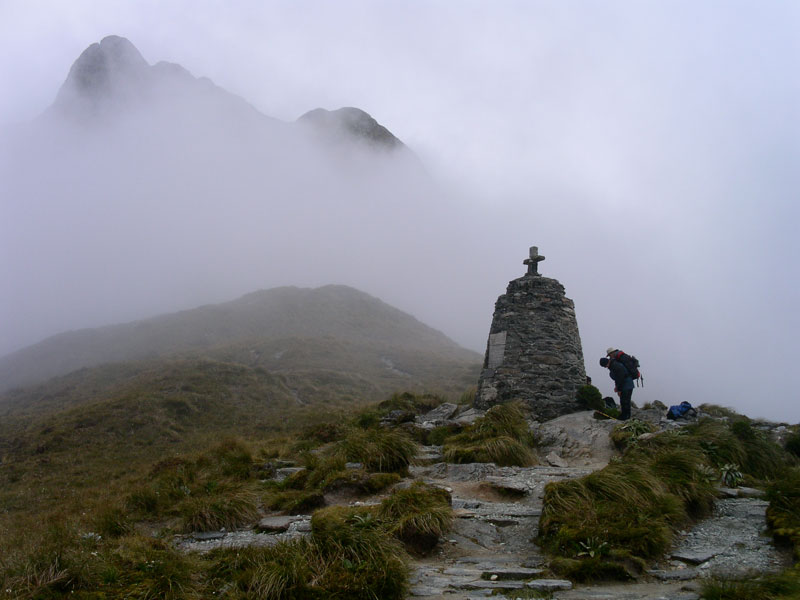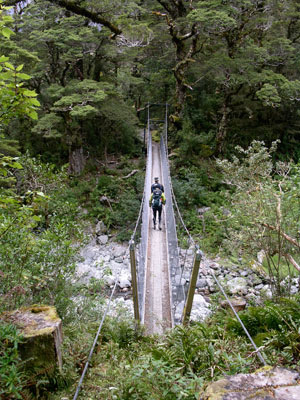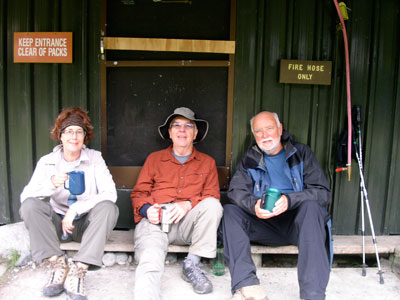Hiking New Zealand’s Milford Track
This item appears on page 34 of the May 2014 issue.

Frank Cunningham — South Haven, MI
New Zealanders like to refer to the Milford Track as “the finest walk in the world,” and they have a point. I’ve had the good fortune to take some terrific hikes over varied terrain — restful countryside, awesome mountains, captivating seascapes and even the Grand Canyon, rim to rim — and I found the Milford Track stunning.
About the track
Any dedicated hiker will be well rewarded by the spectacular alpine terrain and the temperate rainforest, thick with towering beech trees, huge ferns and mountain holly, and fuchsias bigger than lilac bushes. Epiphytes cling to everything in a dazzling array of color and form, while birdsong provides the soundtrack.
Walkers need fear no predators, unless you include the kea, a large mountain parrot that has learned to unzip and unclip unattended gear. These birds steal everything, from shoes and hats to cameras and phones.
But there is a word any potential hiker should keep in mind: wet.
Several days before hiking the track, I met a woman in Dunedin who had recently completed it. She was suitably enthusiastic about the experience but curtly advised me to “give up all hope of ever having dry feet.” The thought of up to four days of rigorous hiking in wet shoes and socks dampened my enthusiasm a bit.
The reason for this reality? The track is located in New Zealand’s Southern Alps, about as far south as Burlington, Vermont, is north, with higher, more rugged mountains. Although the area is more temperate than its New England counterpart, its latitude (45°S) is known as the “Roaring Forties” because of the abundant wind and rain that rolls in from the Southern Ocean and the Tasman Sea. There’s so much precipitation that area residents think they’re in a drought if they go four days without rain.
Water, water everywhere
The track lies in the heart of this weather pattern. It runs from Lake Te Anu up the Clinton River Valley — which averages 268 inches of rain during the hiking season, from late October to late April — over the Mackinnon Pass and down the Arthur River Valley to Milford Sound. (The Arthur River side is only a bit less rainy.)
Under these conditions, the experience is much defined by water, including torrential river flows; towering waterfalls; deep-blue pools; dozens of streamlets crossing the trail, and hundreds of string and ribbon falls lining the mountains and dropping thousands of feet into obscure lakes or to feed the two rivers.
Because sudden rains can bring flash floods, sections of the trail are lined with green metal fence posts capped with blaze-orange plastic tubes that mark the way when the posts are under water.
The rangers will close the trail when the water gets more than knee deep. If that happens, hikers have to hole up at one of the overnight huts until the water clears, so “trampers,” as New Zealanders call hikers, are advised to carry an extra day’s worth of food.
The ranger at the second night’s Mintaro Hut told of a rare occurrence: floods stranded a group of 40, and after three days they were airlifted out by helicopter.
On another water front, the potential for the bacteria Giardia makes the hike seem like the seagoing experience of “water, water everywhere but not a drop to drink.” Trampers are encouraged to carry drinking water and to refill only at the shelters or designated sources on the trail. They are warned against taking water from streams and pools. The rangers echo the caution, but they like to qualify it.
Ross, a lanky 6'5" ranger, said, “I’ve been working here for eight years. I drink stream water daily and have had no problems. And I was 5'8" when I first got here!” Ranger Katie Pao, who doesn’t look a day over 30, reinforced the pro-drinking sentiment, saying she drinks the stream water and that she was really in her early 50s.
Heading out
The trailhead is accessed by a high-speed catamaran trip up Te Anu, a mountain-encircled inland lake. We cruised for 1½ hours in a misty drizzle under low-lying clouds (not low enough, however, to obscure the dramatic heights of the fjords). Once on the trail, we walked to our first hut that afternoon in light rain. Night brought an inauspicious downpour.
But sometimes good fortune smiles. We woke to a brilliant sun and spectacular vistas, a pattern that followed us for three days. Even in the often-shrouded Mackinnon Pass, with a brisk summer temperature of 38°F and 10- to15-mile-per-hour winds, the view down both river valleys was clear and inspiring.
About an hour into our descent into the Arthur River Valley, I looked back to see a cloud-encrusted pass. And on the prior day, sleet made the pass a trial to be tolerated. We had luckily slipped through a narrow window.
That night, at the Dumpling Hut, the ranger told us to expect rain for our final day. Instead, we had six hours of hiking under azure skies and a gorgeous late-summer sun. I reached Milford Sound with dry feet encased in dry socks and dry hiking shoes after four glorious days of tramping.
Perhaps it was inevitable. On the day we started the hike, we took the bus out of Queenstown in the early-morning darkness for the 3-hour ride to Te Anu. As the sun rose, it formed two perfect rainbows between a couple of freshly snowed peaks in The Remarkables.
My traveling companions, Garry and Lynne, and I commented nearly in unison that, surely, it was a good omen. No doubt!
This March 2012 trip with my two friends from Melbourne, Australia, was an independent hike. Garry and Lynne made the arrangements online; 40 individual permits are issued each day to independent hikers.
We brought and prepared our own food, following a strict “carry out what you carry in” policy. The current fee is NZD162 ($140) per adult, which includes the permit and use of the three huts along the track plus a ferry pickup at the trail's end at Sandfly Point for transport across the sound to Milford. Each hut has toilet and cold shower facilities, bunks (but no bedding) and several burners for preparing food.
Guided tours are also available, and we crossed paths with some of those folks but did not stay in the same huts with them. They had hot showers and meals provided, along with a trail guide.


